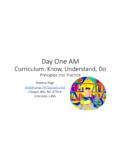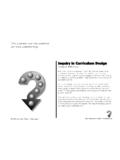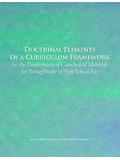Transcription of Formative Assessment: What Do Teachers Need to Know …
1 OCTOBER 2007 Volume 89 Number 2. Formative assessment : what Do Teachers Need to know and Do? To many of today's Teachers , assessment is synonymous with high-stakes standardized tests. But there is an entirely different kind of assessment that can actually transform both teaching and learning. Ms. Heritage describes what the skillful use of Formative assessment would look like. By Margaret Heritage Formative assessment , if used effectively, can provide Teachers and their students with the information they need to move learning forward. But after more than a hundred years of exhortations and a significant body of research on the topic, the idea that assessment and teaching are reciprocal activities is still not firmly situated in the practice of educators. Instead, assessment is often viewed as something in competition with teaching, rather than as an integral part of teaching and learning. In our current accountability environment, assessment is not regarded as a source of information that can be used during instruction.
2 Instead, it has become a tool solely for summarizing what students have learned and for ranking students and schools. In the process, the reciprocal relationship between teaching and assessment has been lost from sight. In a context in which assessment is overwhelmingly identified with the competitive evaluation of schools, Teachers , and students, it is scarcely surprising that classroom Teachers identify assessment as something external to their everyday practice. Educators recognize that annual state tests provide too little information that arrives too late for planning instruction, and this has prompted districts and schools to supplement state assessments with interim or benchmark assessments. These typically consist of item banks, administration tools, and customized reports, and they usually are administered uniformly to all students three to four times a year. Their greater frequency notwithstanding, these assessments still do not provide Teachers with information they can use for ongoing instruction.
3 Despite the enthusiasm for these assessments at the district level and the considerable resources that are being expended on them, the fact remains that they cover too long a period of instruction and provide too little detail for effective use in ongoing instructional planning. At best, they function more as snapshots of student progress and as predictors of student performance on the end-of- year, statewide tests. Indeed, Dylan Wiliam and Marnie Thompson suggest that they might better be described as "early warning summative" tools rather than as tools that can be Formative to Furthermore, Teachers do not control how or when these tests occur, what the purpose of the assessment is, or who is assessed. Yet these are the assessments that "count," even though they offer little help to Teachers in their daily practice. Compounding these difficulties is the fact that assessment has traditionally not been a focus of preservice and inservice courses. As Richard Stiggins laments, educators are "a national faculty unschooled in the principles of sound assessment .
4 "2 Teachers learn how to teach without learning much about how to assess. Moreover, their administrators also lack training in assessment and therefore do not have the skills to support the development of assessment competencies. what is missing in assessment practice in this country is the recognition that, to be valuable for instructional planning, assessment needs to be a moving picture -- a video stream rather than a periodic snapshot. If assessment is used to inform effective instruction, then that assessment is quickly rendered out of date. Student learning will have progressed and will need to be assessed again so that instruction can be planned to extend the students' new growth. Formative assessment practices, if implemented effectively, can provide Teachers and their students with the data that they need. Moreover, there is empirical evidence that Formative assessment , unlike benchmark assessments, is effective in improving student However, in a profession that already feels burdened by the amount of assessment , there is a danger that Teachers will see Formative assessment as yet another external demand that takes time away from teaching.
5 what Is Formative assessment ? Formative assessment is a systematic process to continuously gather evidence about learning. The data are used to identify a student's current level of learning and to adapt lessons to help the student reach the desired learning goal. In Formative assessment , students are active participants with their Teachers , sharing learning goals and understanding how their learning is progressing, what next steps they need to take, and how to take them. Formative assessment involves a variety of strategies for evidence gathering, which can be categorized into three broad types: on-the-fly assessment , planned-for interaction, and curriculum-embedded On-the-fly assessment . On-the-fly assessment occurs spontaneously during the course of a lesson. For example, a teacher listening to group discussions hears students expressing misconceptions about the science concept she has been teaching. She then changes the direction of her lesson to provide a quick "pop-up" The pop-up lesson enables the teacher to clear up the misconceptions before proceeding with her planned instructional sequence.
6 Planned-for interaction. In planned-for interaction, Teachers decide beforehand how they will elicit students' thinking during the course of instruction. For example, Teachers plan the questions they will ask during the course of the lesson in order to enable students to explore ideas, and these questions can elicit valuable assessment Curriculum-embedded assessments. There are two kinds of curriculum-embedded assessments, those that Teachers and curriculum developers embed in the ongoing curriculum to solicit feedback at key points in a learning sequence and those that are part of ongoing classroom activities. For example, student mathematical representations created during lessons can function as Formative assessments, as can students' science notebooks that are also part of students' regular classroom Elements of Formative assessment There are four core elements of Formative assessment : 1) identifying the "gap," 2) feedback, 3) student involvement, and 4) learning progressions.
7 Teachers need to have a clear understanding of each of these elements. Identifying the gap. In a seminal paper in 1989, Royce Sadler established the essential purpose of Formative assessment as the means to identify the gap between a student's current status in learning and some desired educational goal. He stressed that this gap will vary from student to student and spelled out the consequence for pedagogy: "If the gap is perceived as too large by a student, the goal may be unattainable, resulting in a sense of failure and discouragement on the part of the student. Similarly, if the gap is perceived as too 'small,' closing it might not be worth any individual effort. Hence, to borrow from Goldilocks, Formative assessment is a process that needs to identify the 'just right gap.'"8. Educational psychologists call this "just right gap" the zone of proximal development (ZPD). Originating with Lev Vygotsky's still-influential formulation, the ZPD is defined as the distance between what the child can accomplish during independent problem solving and the level of problem solving that can be accomplished under the guidance of an adult or in collaboration with a more expert The teacher 's task is to identify and build on immature but maturing structures and, through collaboration and guidance, to facilitate cognitive growth.
8 In the process, the child internalizes the resources required for solving a particular problem, and these resources become part of the child's independent developmental achievement. The term "scaffolding" characterizes the support that adults give to learners in the ZPD to move them from what they already know to what they can do Effective Formative assessments, then, should identify what a student might achieve in his or her ZPD and enable Teachers to adapt teaching to close the gap between the student's current state of learning and the desired state. Feedback. Formative assessment is designed to provide feedback at multiple levels. First, it provides feedback to the teacher about current levels of student understanding. This feedback also informs what the next steps in learning should be. Feedback also is central to guiding students through their own next steps. Sadler's model strongly emphasizes feedback to students through the use of the feedback loop. This loop involves Teachers and their students in an ongoing process.
9 Effective feedback from Teachers provides clear, descriptive, criterion- based information that indicates to the students where they are in a learning progression (defined below), how their understanding differs from the desired learning goal, and how they can move forward. The teacher takes steps to close the gap between the students' current learning and the goal by modifying instruction, assessing again to give further information about learning, modifying instruction again, and so on. In Formative assessment , learners must be able to use feedback to improve their Another important aspect of the relationship between feedback and learning is that feedback has a strong effect on students' motivation and their sense of self-efficacy -- how they feel about their various abilities -- both of which are major influences on learning. Student involvement. Improving learning through Formative assessment also depends on the active involvement of students in their own In Formative assessment , students learn the skills of self- and peer assessment so that, as Sadler suggests, they collaborate with their Teachers in developing a shared understanding of their current learning status and what they need to do to move forward in their learning.
10 In doing so, they are using metacognitive processes. They reflect on their learning, monitoring what they know and understand and determining when they need more information. They also develop self-regulation strategies and are able to adapt their learning tactics to meet their own learning needs . Students must also collaborate with their Teachers to determine the criteria for success for each step along the learning progression. Learning progressions. If Formative assessment is to provide guidance to Teachers and students, it must be linked to a learning progression. The learning progression should clearly articulate the subgoals that constitute progress toward the ultimate goal. Most state standards, by themselves, do not provide a clear progression for understanding where students are relative to desired goals. In fact, many state standards do not even provide a clear picture of what learning is expected. Developing learning progressions toward standards is a critical element of Formative assessment .



![The Ontario Curriculum, Grades 1-8, Language [revised] 2006](/cache/preview/d/5/3/5/d/c/7/4/thumb-d535dc7439a04910d8a17bf7f1d6b83f.jpg)



